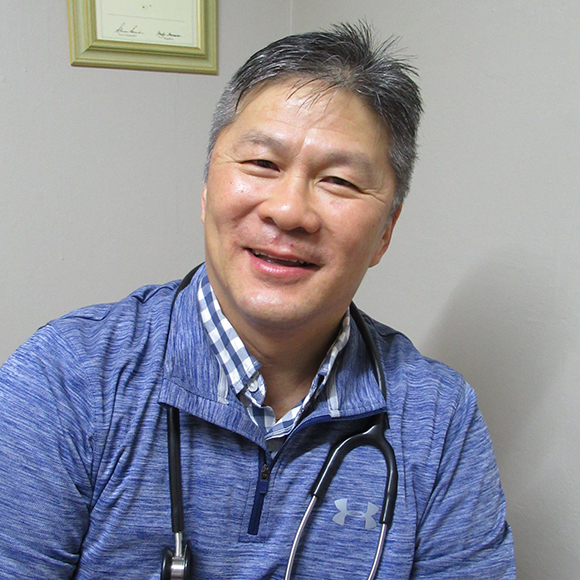Why I’m embracing the digital healthcare era’s titanic potential

Today’s doctors find themselves in a world characterised by disruptive digital forces. As the Fourth Industrial Revolution brings waves of change to healthcare, it’s up to us to learn to wield this evolution’s offerings as well as possible.
Globally, healthcare costs are skyrocketing. This trend has, for years, been fuelled by increasing demand for services by ageing populations, the growing number of patients with non-communicable diseases, the increasing prevalence of high-cost treatment options and other such factors. I believe that digital healthcare innovations offer solutions to these problems that we cannot ignore.

55-year-old GP, Dr Stuart Loyson embraces the digital healthcare era in his day-to-day work
We must respond to the needs of our digitally savvy patients
Another layer of this story is that today’s tech-savvy patients expect tech-savvy doctors to put them at the centre of care, using electronic platforms. A 2019 Willis Towers Watson study found that 41% of workers aged 18 to 24 – the millennial task force and our next patient generation – would rather go online and use video links to access GP services, while only 16% of those aged 55 and over shared this view.
It’s not unusual for patients to arrive at my consultations having already accessed online information – whether reliable or not – relating to their symptoms. Our patients are increasingly digitally connected, informed and empowered.
Also, a recent West Corporation study showed that Americans were 21% less likely to call a healthcare provider telephonically in 2018, than they were in 2011. This is not because patients are less interested in communicating with providers - 74% of patients needed more communication outside of appointments. Patients want additional, digital options for communication.
From paper-based systems to digital advances and beyond
Around 28 years ago, when I first started out in a (paper-based) private practice, the telephone was our only means of speedy communication with colleagues, patients and medical schemes. Almost three decades later, we work in a hyper-connected world where access to real-time, accurate, digitally-enabled information is a given, an imperative.
The introduction of electronic health records (EHR) on Discovery HealthID via an iPad app in 2012 brought a sea of change. Suddenly, with patient consent, we were able to view a patient’s health history; access blood, pathology and radiology results; and write electronic prescriptions and referrals to other healthcare professionals. We could update treatment notes and plans, see prescribed medicines, see whether patients adhere to treatment, whether they access a generic drug, review possible drug and over-the-counter medicine interactions, apply for scheme authorisations in real time, and more.
DrConnect also lets doctors share their knowledge and expertise by answering user questions and training the new AI-powered symptom checker. In addition, doctors can connect and consult with their peers on complex cases and referrals.
As with all new technologies, there has to be a starting point. Virtual consultation technology is still relatively new to patients, and doctors also fear the liability that could come with missing something during a remote consult. With greater awareness around these platforms, these issues will be addressed. We can choose whether to get involved in and offer clinical direction towards the design and effectiveness of these technologies.
The effect of digital platforms is determined by our choice to wield them well
When I first see a patient, there is no technology between us. I introduce a patient’s electronic record only after giving them the first 90 seconds of our consultation to speak, uninterrupted, and explain their situation. Patients need to feel heard. Then, we look at their HealthID record – together. Seeing their electronic health record assists them to take ownership of and understand their health. The human desire to engage with another person will never fade, especially when we are sick and most vulnerable. But technology allows us to expand our reach on various levels and gives our patients options for heightened, on-demand access to primary healthcare.
I also use technology to get patients to practise healthy living. I am a runner and member of the Vitality Active Rewards for Doctors programme. My fitness watch is invaluable for tracking my progress and activity. I encourage my patients to get a wearable fitness device and, if they are Discovery clients, to upload their exercise data each week to the Discovery app and earn Vitality Active Rewards for reaching their weekly goals. In this way, we can reflect on the effect of physical activity and medical treatment combined, when I see them.
We should, collectively, embrace the digital era in healthcare
I am hardly an early adopter when it comes to new technologies. I don’t own the latest gadgets. But, I do support medical platforms and innovations that work. Digital healthcare trends are manifesting all around us. We cannot stop the evolution that they have brought, neither should we fear using digital tools. Let’s make it a priority to understand them and wield them well.
HealthID is a digital patient-management platform available through the Healthcare Professional Zone on the Discovery website.
Access DrConnect, an online medical advice service with trusted knowledge built up by over 100 000 doctors here.
Related articles
Doctors and machines: Embrace the future
Digitisation and artificial intelligence-based innovations have become catalysts to the evolution of the healthcare industry. GP, Dr Sudeshan Govender, describes how digital healthcare tools are increasingly augmenting the doctor-patient relationship.